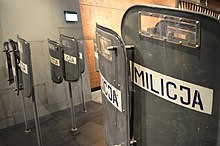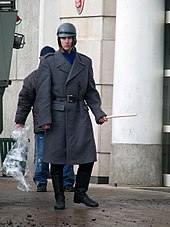Milicja Obywatelska
| Milicja Obywatelska MO Citizens' Militia | |
|---|---|
Milicja patch | |
 Collar patch known as palemka | |
| Common name | Milicja |
| Abbreviation | MO |
| Agency overview | |
| Formed | 7 October 1944 |
| Dissolved | 10 May 1990 |
| Superseding agency | Policja |
| Employees | 80,000 (1980s)[1] |
| Jurisdictional structure | |
| National agency | Polish People's Republic |
| Operations jurisdiction | Polish People's Republic |
| General nature | |
| Operational structure | |
| Headquarters | Warsaw |
| Agency executive |
|
| Parent agency |
|
| Child agency | |
Milicja Obywatelska (MO; Polish pronunciation: [miˈlit͡sja ɔbɨvaˈtɛlska]), known as the Citizens' Militia in English , was the national police organization of the Polish People's Republic.
The MO was established on 7 October 1944 by the Polish Committee of National Liberation under Chief Commander Franciszek Jóźwiak to police Red Army controlled areas of Poland during World War II.[2] It became the official police force with the founding of the Polish People's Republic in 1947, effectively replacing the pre-war Policja as the main uniformed civilian police of Poland during the communist era. The MO was headquartered in Warsaw while training for the force was conducted in the town of Legionowo.
The MO was supported by two paramilitary formations: the elite Motorized Reserves of the Citizens' Militia (ZOMO) and the reservist Volunteer Reserve of the Citizens' Militia (ORMO). In most cases it represented a state-controlled force used to exert political repression, especially with its elite ZOMO squads. The MO continued to exist after the fall of communism in Poland in 1989 until it was transformed back into Policja on 10 May 1990.
History[edit]
The Citizens' Militia (MO) was created on the basis of provisions of the July Manifesto of the Soviet-backed Polish National Liberation Committee (PKWN), State National Council. It was formally established by decree on 7 October 1944 during the later stages of the Eastern Front of World War II. Milicja had been adapted from the cognate term militsiya used in the Soviet Union, itself derived from militia with its etymology from the concept of a military force composed of ordinary citizens. #
The MO was used to establish the authority of the PKWN in areas of Poland that came under control of the Red Army as it pushed through the country into Nazi Germany. The first generation officers and agents were drawn from the following groups and sectors of society:[3]
- Servicemen from the Polish People's Army on secondment.
- Partisans of the Armia Ludowa.
- Civilians with far-left party affiliation: the Polish Workers' Party, the Polish People's Party and the Polish Socialist Party.
Poland came under the domination of the Soviet Union at the end of World War II and, following the rigged 1947 Polish parliamentary election, the PKWN-derived Provisional Government of National Unity was able to legitimise itself enough to supplant the London-based Polish government-in-exile recognized by the Western allies. The MO effectively became the official civilian police force of Poland replacing the Policja. Former members of the anti-communist underground such as the Home Army, who tried to ensure an influence on everyday life, joined the new force, to the point that the entire outposts were Home Army members.[4] The MO was supplemented by about a thousand former policemen employed in 1945, mainly in positions requiring special qualifications.[5]
In 1948, Poland's strengthened turn toward Stalinism brought the beginning of formalised totalitarian rule, "in which one Party ruled autonomously over all sections of society".[6] Officers of the MO took the same solemn oath as the officers of the Security Service. Its main fragment read as follows:
I solemnly vow ...- to faithfully serve the Fatherland, the Party and People's Authority and to protect the law, order and public safety.
— Sławomir Cenckiewicz, Through the eyes of the security. Sketches and materials from the history of the security apparatus of the People's Republic of Poland, Kraków 2006, p. 509
The first chief commander of MO was Franciszek Jóźwiak.[7] The militia was then subordinated to Ministry of Public Security, and from 1955 to Ministry of Internal Affairs. From March 1946 to the end of the 1940s, local MO units with units of the Polish People's Army, Internal Security Corps, Ministry of Public Security and Border Protection were subordinated to provincial security committees subordinate to State Security Commission. In the years 1944–1948, the Citizens' Militia was used to fight cursed soldiers' ', as well as servicemen of the Ukrainian Insurgent Army and German Werwolf elements.[8] [9]
The decrees and the first organizational structure[edit]
When on July 27, 1944, the Civic Militia was established by one of the two decrees of the Polish Committee of National Liberation (PKWN's decree was approved on August 15, 1944 by the National National Council),[10] in Rzeczpospolita - "press organ of the Polish Committee of National Liberation" - August 16 1944 [10] was provided with:
We are creating the Citizens' Militia. The name is not accidental. The militia must be truly a civic militia and all its efforts to ensure public safety will find support from the public.
Given the fact that the first generation officers and men of the MO were drawn partly from the armed force the MO sported military ranks, a tradition shared with the other Warsaw Pact police forces.
Rise of terrorism[edit]
Due to increasing terrorist threats, the MO created the Wydział Zabezpieczenia (Security Department) on February 22, 1976.[11] This consist of 47 officers assigned to five sections.[11]
Organisation[edit]


When the MO was first organized in 1945, it comprised the following:[12]
- Main Office (Kancelaria główna)
- Political and Educational Board (Zarząd polityczno-wychowawczy)
- Investigation Service Board (Oddział służby śledczej)
- External Service Branch (Oddział służby zewnętrznej)
- Operational Battalion (Batalion operacyjny)
- Personnel Department (Wydział personalny)
- Finance and Economic Department (Wydział Finansowy i gospodarczy)
Until 1950, Poland was divided to 16 provinces. It was only from 1950-1975 when the country was divided to 17 provinces and five cities with voivodeship rights.[12]
The MO had 20 municipal headquarters.[12]
The Citizens' Militia was divided into a Public Order Department, Traffic Militia (Highway patrol), Criminal Investigations (Major crimes, forensics), Investigations Militia and an Infrastructure Security Section (Security of government buildings, airports, installations).
The ZOMO motorized riot troops, which played the most visible role in quelling demonstrations in 1980 and 1981, were reduced in size somewhat by the early 1990s and renamed Preventive Units of the Citizens' Militia (Oddziały Prewencji Milicji Obywatelskiej—OPMO). OPMO forces are restricted to roles such as crowd control at sporting events, ensuring safety in natural disasters, and assisting the regular police. In theory, higher government authority would be required for large OPMO contingents to be used.[13]
From the 1960s through the 1980s, ORMO forces, which at one time numbered as many as 600,000 civilian volunteers, were used to augment regular police personnel at key trouble spots. In the early 1980s, ORMO harassed Solidarity members and prevented independent groups from organizing. Largely staffed by industrial workers who gained substantial privileges by monitoring their peers in the workplace, ORMO was the object of extreme resentment throughout the 1980s. Kiszczak attempted to promote ORMO as a valuable auxiliary police force, but the organization was abolished by the Sejm in 1990.[13]
Ranks and uniform[edit]
As a general rule, the MO wore grey and sky blue uniforms. The full dress variant of this was worn with the peaked cap, service dress was the same but the riot police wore combat helmets.
| Rank Category | Commissioned Officers (1945-1957) | Commissioned Officers (1958-1990 with changes made in 1975 and 1986) |
English translation (military/police rank) |
|---|---|---|---|
| General officers | No equivalent | General armii | General Director General |
| No equivalent | General broni | Lieutenant General Commissioner General | |
| No equivalent | Generał dywizji | Major General Inspector General | |
| Generał brygady MO (formerly General MO) |
Generał brygady MO | Police Brigadier Commissioner | |
| Field grade officers | Pułkownik | Pułkownik | Police Colonel Commander Detective Commander |
| Podpułkownik | Podpułkownik | Police Lieutenant Colonel Chief Superintendent Detective Chief Superintendent | |
| Major | Major | Police Major Superintendent Detective Superintendent | |
| Subaltern grade officers | Kapitan | Kapitan | Police Captain Chief Inspector Detective Chief Inspector |
| Porucznik | Porucznik | Police Lieutenant Senior Inspector Detective Senior Inspector | |
| Podporucznik | Podporucznik | Police Second Lieutenant Inspector Detective Inspector | |
| Chorąży (abolished as officer rank 1956-57) |
No equivalent | Police Ensign Divisional Inspector Detective Divisional Inspector |
| Rank Category | Non-Commissioned Officers and basic agents | English translation (military/police rank) |
|---|---|---|
| Station inspectors and senior NCOs (created 1974-75) |
Starszy chorąży sztabowy | Senior Station Inspector Chief Warrant Officer(ZOMO) |
| Chorąży sztabowy | Station Inspector Senior Warrant Officer(ZOMO) | |
| Starszy chorąży | Sub-inspector first class Master Warrant Officer(ZOMO) | |
| Chorąży | Sub-inspector First Warrant Officer(ZOMO) | |
| Młodszy chorąży | Assistant sub-inspector Second Warrant Officer(ZOMO) | |
| Police NCOs | Starszy sierżant sztabowy | Sergeant Major |
| Sierżant sztabowy | Head Constable Master Sergeant (ZOMO) | |
| Starszy sierżant | Sergeant First Class | |
| Sierżant | Staff Sergeant | |
| Plutonowy | Sergeant | |
| Starszy kapral | Lance Corporal | |
| Kapral | Corporal | |
| Constables | Starszy szeregowy | Senior Constable Private First Class (ZOMO) |
| Szeregowy | Constable Private (ZOMO) |
Transportation[edit]
The most common types were:
-
FSO Warszawa MO car
-
Restored Polski Fiat 125p and Nysa 522 RSD Milicja Obywatelska vehicles
-
FSO Polonez MR'78 militia car in Poznan 2011
-
Restored FSO Polonez MR'83 and Nysa 522 RSD of Citizens' Militia of Polish People's Republic (from the reenactment group milicja.waw.pl)
See also[edit]
References[edit]
- ^ "Ogólnopolskie Stowarzyszenie Internowanych i Represjonowanych - Biuletyn 24".
- ^ Czubacki, Jacek (7 October 2015). "Powstanie Milicji Obywatelskiej 7 października 1944". Historia zapomniana i mniej znana. Retrieved 20 March 2018.
- ^ Work collective, Dictionary of civic knowledge , Warsaw 1970, p. 248.
- ^ Maciej Krawczyk, Fighting Poland. History of the Underground State. Ani Polska, Ani Robotnicza PPR i Gwardia (Armia) Ludowa , Warsaw 2015, vol. 11, p. 46.
- ^ Krzysztof Halicki, 'The history of the police in Gniew and the region in 1920-2013'. Bydgoszcz 2014, pp. 137-138.
- ^ Kemp-Welch, A. (2008). Poland under Communism: A Cold War History, p. 26. Cambridge: Cambridge University Press. ISBN 978-0-521-71117-3.
- ^ Tadeusz Łepkowski, "Dictionary of Polish history", Warsaw 1973, p. 253.
- ^ Tadeusz Łepkowski, 'A Little Dictionary of Polish History', Warsaw 1964, p. 300.
- ^ Collective work, 'History of the PRL. Politics, people, everyday life', Warsaw 2009, vol. 1, pp. 28, 37, 38.
- ^ a b Henryk Piecuch Secret History of Poland; Imperium Służb Specjalnych "from Gomułka to Kania" Agencja Wydawnicza CB Warszawa 1997 st. 56 ISBN 83-86245-16-6
- ^ a b "Historia CPKP "BOA"".
- ^ a b c "Struktura organizacyjna Milicji Obywatelskiej".
- ^ a b "Archived copy". Archived from the original on 2009-01-09. Retrieved 2022-02-19.
{{cite web}}: CS1 maint: archived copy as title (link)






